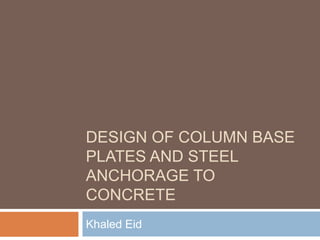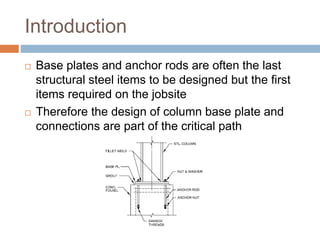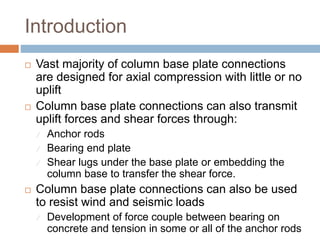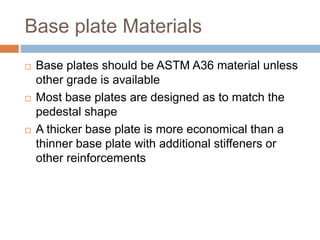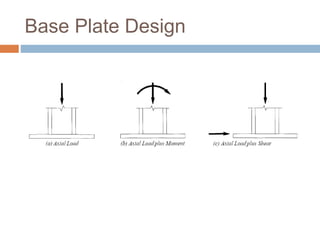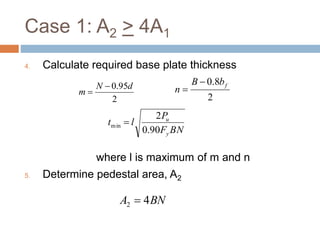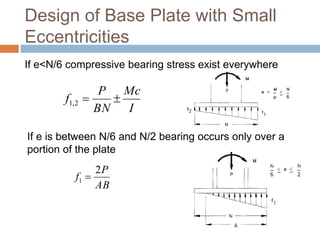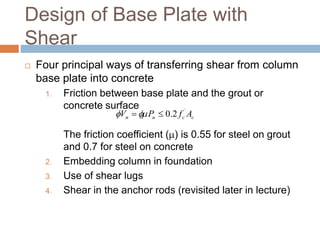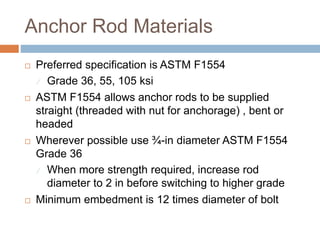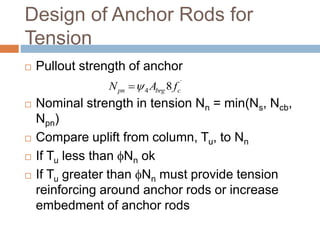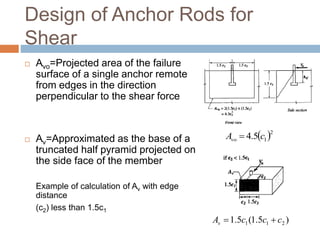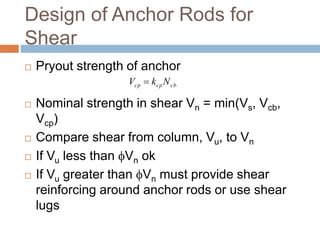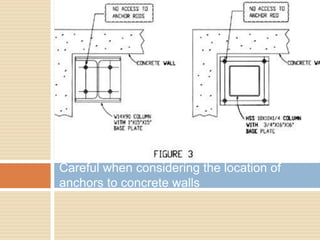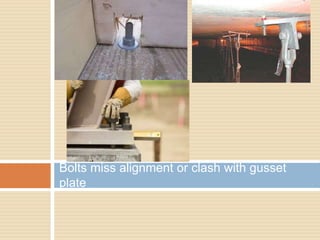Design of column base plates anchor bolt
- 1. DESIGN OF COLUMN BASE PLATES AND STEEL ANCHORAGE TO CONCRETE Khaled Eid
- 2. Outline Introduction Base plates Material Design using AISC Steel Design Guide Concentric axial load Axial load plus moment Axial load plus shear Anchor Rods Types and Materials Design using ACI Appendix D Tension Shear
- 3. Introduction Base plates and anchor rods are often the last structural steel items to be designed but the first items required on the jobsite Therefore the design of column base plate and connections are part of the critical path
- 4. Introduction Anchors to appear in concrete drawings with location of each anchor in x and y direction Pedestal should be designed to suit the supporting column and anchors Usually allow for enough edge distance of 6d bolt Usually use to nuts to avoid slip
- 5. Introduction Vast majority of column base plate connections are designed for axial compression with little or no uplift Column base plate connections can also transmit uplift forces and shear forces through: Anchor rods Bearing end plate Shear lugs under the base plate or embedding the column base to transfer the shear force. Column base plate connections can also be used to resist wind and seismic loads Development of force couple between bearing on concrete and tension in some or all of the anchor rods
- 6. Introduction Anchor rods are needed for all base plates to prevent column from overturning during construction and in some cases to resist uplift or large moments Anchor rods are designed for pullout and breakout strength using ACI 318 Appendix D Critical to provide well-defined, adequate load path when tension and shear loading will be transferred through anchor rods In seismic zones the pedestal should carry 2.5 the factored design load
- 7. Introduction Grout is needed to adjust the level Grout to transfer the load from steel plate to foundation Grout should have design compressive strength at least twice the strength of foundation concrete When base plates become larger than 600mm, it is recommended that one or two grout holes be provided to allow the grout to flow easier
- 8. Base plate Materials Base plates should be ASTM A36 material unless other grade is available Most base plates are designed as to match the pedestal shape A thicker base plate is more economical than a thinner base plate with additional stiffeners or other reinforcements
- 10. Design of Axially Loaded Base Plates Required plate area is based on uniform allowable bearing stress. For axially loaded base plates, the bearing stress under the base plate is uniform ` A ` 2 f f max 0.85 1.7 p c c c f A 1 A2 = dimensions of concrete supporting foundation A1 = dimensions of base plate Most economical plate occurs when ratio of concrete to plate area is equal to or greater than 4 (Case 1) When the plate dimensions are known it is not possible to calculate bearing pressure directly and therefore different procedure is used (Case 2)
- 11. Case 1: A2 > 4A1 1. Determine factored load Pu 2. Calculate required plate area A1 based on maximum concrete bearing stress fp=1.7f`c (when A2=4A1) P u req f A 1( ) 0.6 1.7 ` c 3. Plate dimensions B & N should be determined so m & n are approximately equal 1(req) N A 0.95 0.8 f d b 2 N A B 1(req)
- 12. Case 1: A2 > 4A1 4. Calculate required base plate thickness N 0.95d 2 0.8 f B b P u 2 where l is maximum of m and n m 5. Determine pedestal area, A2 2 n F BN t l y 0.90 min A 4BN 2
- 13. Case 2: Pedestal dimensions known 1.Determine factored load Pu 2.The area of the plate should be equal to larger of: 2 A ` 1 0.6 1.7 ` c 1 1 0.60 0.85 2 c u f P A u f P A 3. Same as Case 1 4. Same as Case 1
- 14. Design of Base Plates with Moments Equivalent eccentricity, e, is calculated equal to moment M divided by axial force P Moment and axial force replaced by equivalent axial force at a distance e from center of column Small eccentricities equivalent axial force resisted by bearing only Large eccentricities necessary to use an anchor bolt to resist equivalent axial force
- 15. Design of Base Plate with Small Eccentricities If e<N/6 compressive bearing stress exist everywhere Mc P f 1,2 If e is between N/6 and N/2 bearing occurs only over a portion of the plate P AB f 2 1 I BN
- 16. Design of Base Plate with Small Eccentricities 1. Calculate factored load (Pu) and moment (Mu) 2. Determine maximum bearing pressure, fp A ` 2 0.85 1.7 p c c c f f f A 3. Pick a trial base plate size, B and N 4. Determine equivalent eccentricity, e, and maximum bearing stress from load, f1. If f1 < fp go to next step, if not pick different base plate size 5. Determine plate thickness, tp plu 4 1. Mplu is moment for 1 in wide strip p F y M t 0.90 ` 1
- 17. Design of Base Plate with Shear Four principal ways of transferring shear from column base plate into concrete 1. Friction between base plate and the grout or concrete surface n u c c V P f A ` m 0.2 The friction coefficient (m) is 0.55 for steel on grout and 0.7 for steel on concrete 2. Embedding column in foundation 3. Use of shear lugs 4. Shear in the anchor rods (revisited later in lecture)
- 18. Design of Shear Lugs 1. Determine the portion of shear which will be resisted by shear lug, Vlgu 2. Determine required bearing area of shear lug u f V A lg 0.85 c ` lg 3. Determine shear lug width, W, and height, H 4. Determine factored cantilevered end moment, Mlgu H G M u 2 V lg lg W u 5. Determine shear lug thickness 4 lg u F y M t 0.90 lg
- 19. Anchor Rods Two categories Cast-in place: set before the concrete is placed Drilled-in anchors: set after the concrete is hardened
- 20. Anchor Rod Materials Preferred specification is ASTM F1554 Grade 36, 55, 105 ksi ASTM F1554 allows anchor rods to be supplied straight (threaded with nut for anchorage) , bent or headed Wherever possible use ¾-in diameter ASTM F1554 Grade 36 When more strength required, increase rod diameter to 2 in before switching to higher grade Minimum embedment is 12 times diameter of bolt
- 21. Cast-in Place Anchor Rods When rods with threads and nut are used, a more positive anchorage is formed Failure mechanism is the pull out of a cone of concrete radiating outward from the head of the bolt or nut Use of plate washer does not add any increased resistance to pull out Hooked bars have a very limited pullout strength compared with that of headed rods or threaded rods with a nut of anchorage
- 22. Anchor Rod Placement Most common field problem is placement of anchor rods Important to provide as large as hole as possible to accommodate setting tolerances Fewer problems if the structural steel detailer issued anchor bolt layout for placing the anchors form his 3d model
- 23. Anchor Rod Layout Should use a symmetrical pattern in both directions wherever possible Should provide ample clearance distance for the washer from the column Edge distance plays important role for concrete breakout strength Should be coordinated with reinforcing steel to ensure there are no interferences, more critical in concrete piers and walls
- 24. Design of Anchor Rods for Tension When base plates are subject to uplift force Tu, embedment of anchor rods must be checked for tension Steel strength of N anchor A f in tension s se ut Ase =effective cross sectional area of anchor, AISC Steel Manual Table 7-18 fut= tensile strength of anchor, not greater than 1.9fy or 125 ksi Concrete breakout strength of single anchor in A tension N N N cb 2 3 b N k f ` h 1.5 b c ef No A hef=embedment k=24 for cast-in place anchors, 17 for post-installed anchors 2, 3 = modification factors
- 25. Design of Anchor Rods for Tension ANo=Projected area of the failure surface of a single anchor remote from edges AN=Approximated as the base of the rectilinear geometrical figure that results from projecting the failure surface outward 1.5hef from the centerlines of the anchor Example of calculation of AN with edge distance (c1) less than 1.5hef 2 No 9 ef A h ( 1.5 )(2 1.5 ) N 1 ef ef A c h h
- 26. Design of Anchor Rods for Tension Pullout strength of anchor ` pn 4 brg8 c N A f Nominal strength in tension Nn = min(Ns, Ncb, Npn) Compare uplift from column, Tu, to Nn If Tu less than Nn ok If Tu greater than Nn must provide tension reinforcing around anchor rods or increase embedment of anchor rods
- 27. Design of Anchor Rods for Shear When base plates are subject to shear force, Vu, and friction between base plate and concrete is inadequate to resist shear, anchor rods may take shear Steel Strength of single anchor in shear s se ut V A f Concrete breakout strength of single anchor in shear A 0.2 l V v V 1.5 cb 6 7 b A vo b V o c 7 d f c 1 ` d o 6, 7 = modification factors do = rod diameter, in l = load bearing length of anchor for shear not to exceed 8do, in
- 28. Design of Anchor Rods for Shear Avo=Projected area of the failure surface of a single anchor remote from edges in the direction perpendicular to the shear force Av=Approximated as the base of a truncated half pyramid projected on the side face of the member Example of calculation of Av with edge distance (c2) less than 1.5c1 2 A 4.5 c1 vo 1.5 (1.5 ) 1 1 2 A c c c v
- 29. Design of Anchor Rods for Shear Pryout strength of anchor cp cp cb V k N Nominal strength in shear Vn = min(Vs, Vcb, Vcp) Compare shear from column, Vu, to Vn If Vu less than Vn ok If Vu greater than Vn must provide shear reinforcing around anchor rods or use shear lugs
- 30. Combined Tension and Shear According to ACI 318 Appendix D, anchor rods must be checked for interaction of tensile and shear forces T V u 1.2 n n u V N
- 31. References American Concrete Institute (ACI) 318-02 AISC Steel Design Guide, Column Base Plates, by John T. DeWolf, 1990 AISC Steel Design Guide (2nd Edition) Base Plate and Anchor Rod Design AISC Engineering Journal Anchorage of Steel Building Components to Concrete, by M. Lee Marsh and Edwin G. Burdette, First Quarter 1985
- 32. Common mistakes
- 33. Careful when considering the location of anchors to concrete walls
- 34. Bolts miss alignment or clash with gusset plate

